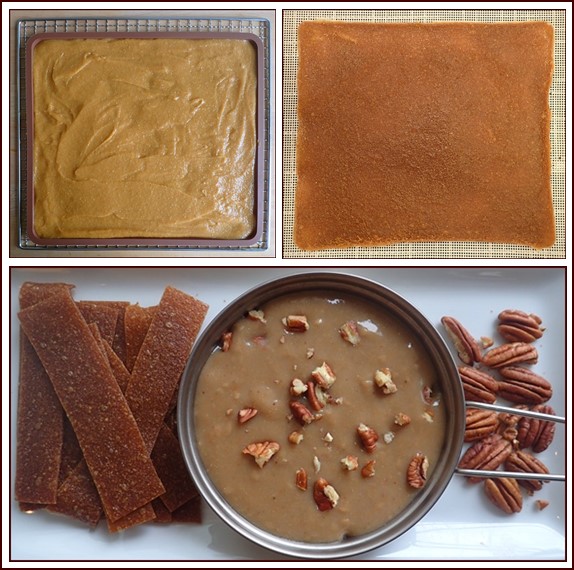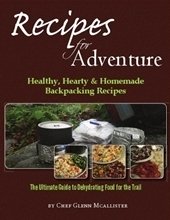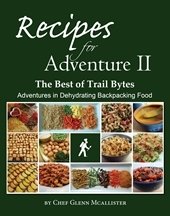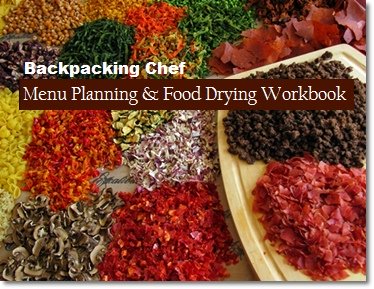Fig Fruit Leather Recipes
I call these fruit leathers
“Figgy Pudding Pops.”
The three fig fruit leather recipes on this page were designed to provide fast energy for hikers, cyclists, and runners. As it turns out, my wife, Dominique, loves them as midmorning snacks at the office.
My son-in-law, who runs marathons, asked me if I could make a high-calorie energy bar or fig fruit leather that he could eat while running to supplement the energy gels that he and many marathon runners use. While energy gels provide quick calories, they don’t provide the chewy satisfaction that real food offers.
Whatever I came up with had to be satisfying in a small quantity, and easy for the body to convert to energy, because long-distance runners can’t eat much while running. The digestive system goes into sleep mode as the rest of the body goes into overdrive pumping water, glucose, and oxygen to the leg muscles. Excess food in the stomach can cause cramps or the runs… not the kind runners want.
During exercise, glycogen, a
form of glucose stored in the muscles and liver, is converted into energy.
Before a 26-mile marathon is over, the stored glycogen is depleted. Runners
call it “bonking,” “hitting the wall,” or “game over” unless additional energy food is supplied.
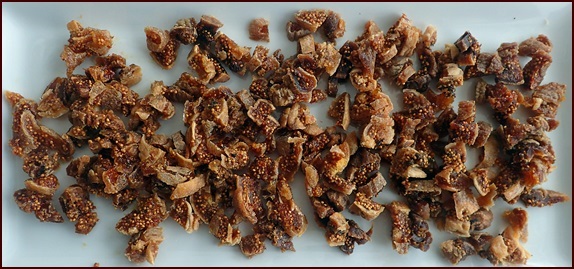
Photo: Dried chopped figs, the main ingredient in fig fruit leather.
Fig fruit leather, made from dried figs, was the obvious choice because dried figs are high in glucose and fructose—sugars that quickly convert to energy. I came up with three varieties: Banana-Fig, Pear-Fig, and Sweet Potato-Apple-Fig. The other ingredients are oats, maple syrup, and salt. I also added lemon juice and zest to the Banana-Fig Fruit Leather.
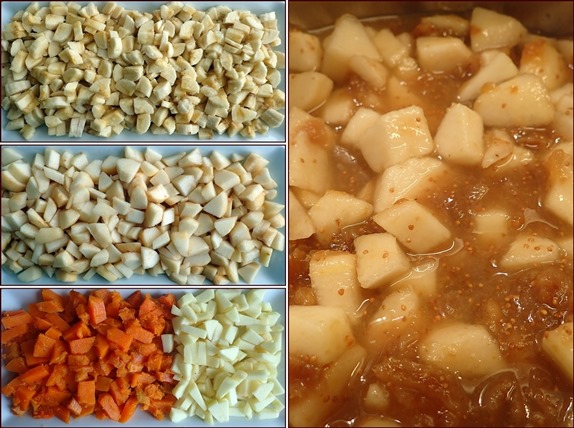
Photo: Bananas, pears, sweet potatoes and apples. Each is cooked with figs and oats.
To ensure the fig fruit leathers are easy-to-digest, the figs, fruits, and oats are cooked and run through a blender. Cooking and blending breaks down the fiber. Think of it as predigesting, so the stomach has less work to do.
I call these fig fruit leathers “Figgy Pudding Pops,” because you can pop them in your mouth while moving down the trail. Backpackers and campers will also love rehydrating figgy pudding pops with hot water into figgy pudding. Throw in some pecans, and figgy pudding meets pecan pie.
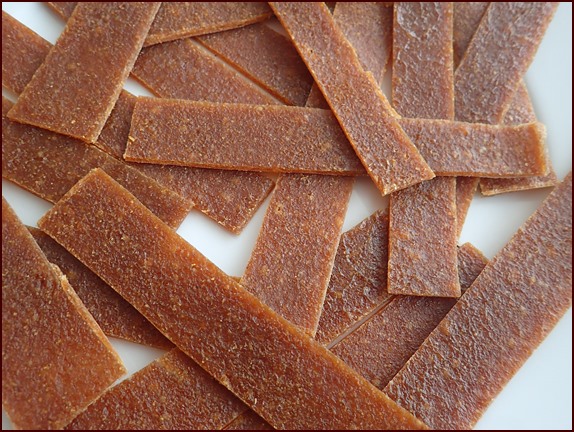
Photo: Figgy Pudding Pops
Fig Fruit Leather Recipes
Each recipe produces approximately two cups of blended fruit to make one fruit leather using one tray of an Excalibur or Cosori dehydrator. If using a smaller, round dehydrator with less capacity, spread the blended fruit on two trays.
These figgy pudding pops are thicker and chewier than regular fruit leathers. You can make thinner leather by spreading less blended fruit on each tray.
Eating Tip: Take your time. Let the enzyme amylase in your saliva work its wonders as it breaks down the sugars and releases the wonderful flavors.
Banana-Fig Fruit Leather
Ingredients:
- 100 g dried figs (6–7 figs)
- 250 g bananas (1½–2 bananas)
- 25 g rolled oats (¼ cup)
- 1 Tbsp. real maple syrup
- ⅛ tsp. salt
- 2 Tbsp. lemon juice and zest from ½ lemon
- 473 ml water (2 cups)
Pear-Fig Fruit Leather
Ingredients:
- 100 g dried figs (6–7 figs)
- 250 g pears (2–3 pears)
- 25 g rolled oats (¼ cup)
- 1 Tbsp. real maple syrup
- ⅛ tsp. salt
- 473 ml water (2 cups)
* Apples or peaches may be used in place of pears to make more varieties.
Sweet Potato-Apple-Fig Fruit Leather
Including apple in the mix makes a less chewy fruit leather than if just sweet potato is used.
Bake sweet potatoes in the oven for approximately 50 minutes at 350°F (175°C) before mixing in with the figs and apples.
Ingredients:
- 100 g dried figs (6–7 figs)
- 200 g baked sweet potatoes (1-2 sweet potatoes)
- 75 g apples (1–2 apples)
- 25 g rolled oats (¼ cup)
- 1 Tbsp. real maple syrup
- ⅛ tsp. salt
- 473 ml water (2 cups)
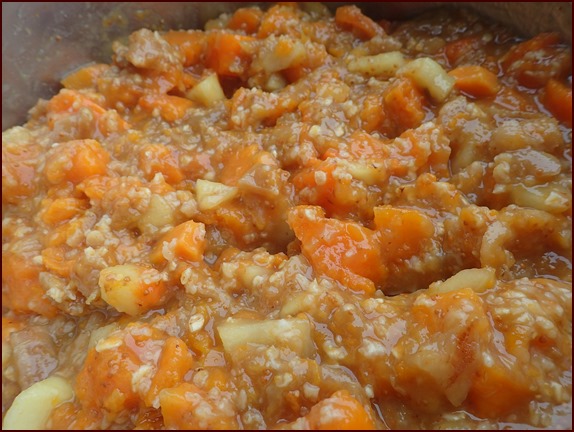
Photo: Cooked figs, sweet potatoes, apples, and oats in pot before blending.
How to Make Fig Fruit Leather
1. Start by cooking the oats in a separate pot. For each leather, combine 25 grams (¼ cup) of rolled oats with 1 cup water and ⅛ tsp. salt. Bring to a boil, then reduce heat to low for 1 minute. Take pot off heat and let stand with the lid on while you cook the figs and fruit in another pot. Cooking the oats separately breaks them down more than if they are added raw to the cooking fruit.
2. Cut off hard stem part of figs, then cut the figs into smaller pieces.
3. Peel and cut fruit into smaller pieces.
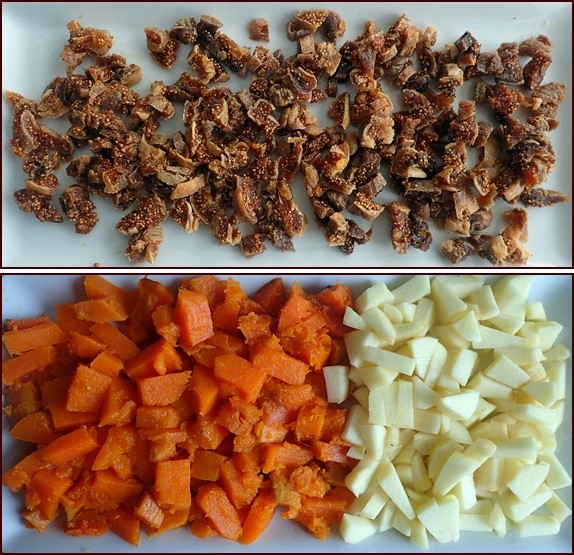
Photos: Cut figs, baked sweet potatoes, and apples.
4. Bring 100 grams of cut figs to a boil in pot with 1 cup water, then reduce heat to simmer for 5 minutes, keeping lid on the pot. Turn off stove and mash figs in the pot with a potato masher.
5. Add cut fruit (and baked sweet potatoes if using) to cooked figs. Turn heat back on to medium until mixture is lightly bubbling. Then, turn off stove and let mixture sit for 4 minutes with lid on the pot.
6. Stir in cooked oats, including all liquid, to cooked fruit.
7. Stir in 1 Tbsp. real maple syrup.
8. For the banana-fig fruit leather recipe, also stir in 2 Tbsp. lemon juice and the zest from half a lemon.
Dehydrating Fig Fruit Leather
1. Run the mixture through a blender on the smoothie setting. If necessary, thin the mixture with 1–2 tablespoons of water.
2. Spread mixture evenly on a nonstick dehydrator sheet or tray. Since these figgy pudding pops are thicker than typical fruit leathers, a silicone tray with raised edges is an ideal accessory to contain the mixture.
Photo: Fig fruit leather mixture spread on silicone dehydrator tray.
3. Dehydrate fig fruit leather at 135°F (57°C) for approximately 14+ hours.
4. After 7 hours, the fig fruit leather should be dry enough to flip over onto a nonstick mesh sheet. Peel off the nonstick sheet or tray. Flipping ensures the bottom of the leather dries as well as the top.
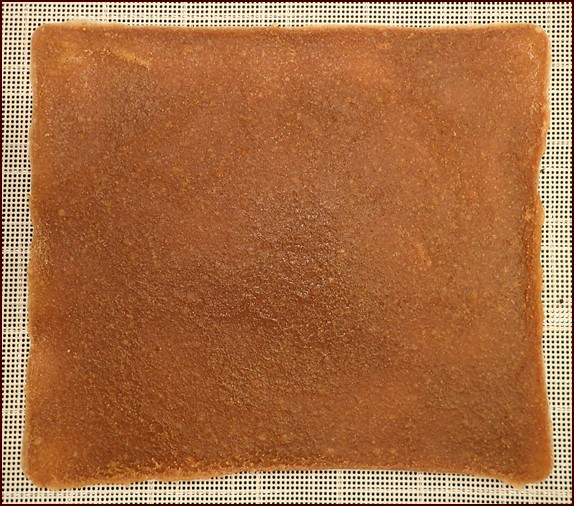
Photo: Fig fruit leather after flipping onto a silicone mesh dehydrator sheet.
5. Once the leather is dry, cut it into strips with scissors. Place back in the dehydrator for an additional 30–60 minutes. Because of the high sugar content of the figs, this final step will reduce some of the stickiness.
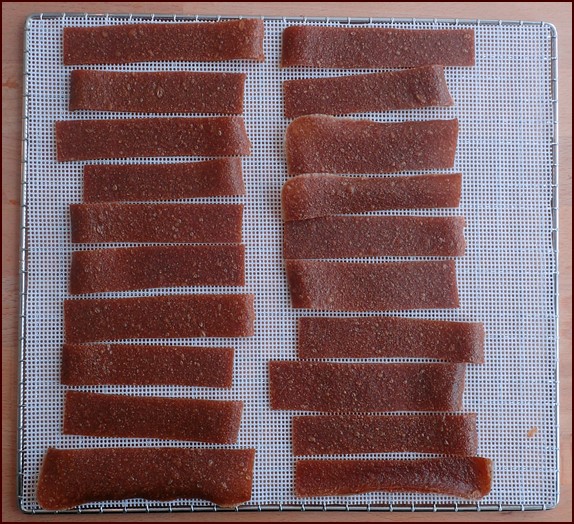
Photo: Figgy pudding pops cut into strips.
Storing & Packing Fig Fruit Leather
Figgy pudding pops are stickier than most fruit leathers. Wrap them in parchment paper or plastic wrap to keep them from sticking together in storage. Store at home in an airtight container so they don’t reabsorb moisture from the air.
Keep them in the fridge if storing for more than a couple of months. Marathon runners will want to cut the strips into smaller pieces that they can pop in their mouth one at a time.
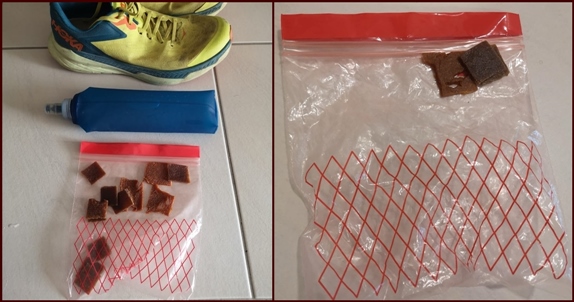
Photo: My son-in-law tested the figgy pudding pops during a half-marathon. He ate all but a few pieces of what he carried. He liked all three flavors, but if he had to choose just one, banana-fig was his favorite.
Figgy Pudding Meets Pecan Pie
If you manage to get through a long day on the trail without eating your stash of pudding pops, they make a fine pudding for dessert.
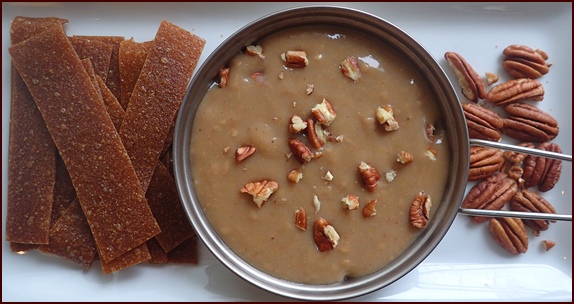
Backpacker’s Figgy Pudding with Pecans
Servings: 1
Ingredients:
- 75 g fig fruit leather (approx. half of one leather)
- 20 g pecan pieces (handful)
- 1 cup water
On the Trail:
Place pudding pop pieces in pot with water. Bring to a boil, then remove pot from stove. Let sit for 20-30 minutes with lid on, and insulate pot if possible. Alternatively, add boiled water to pudding pop pieces in a separate container.
Stir vigorously to dissolve pudding pops, then stir in pecan pieces.
Nutrition in Fig Fruit Leather
These recipes were designed to provide high calories from fast-burning carbohydrates, primarily glucose and fructose naturally present in the figs and fruit.
As prepared, each leather provides the following calories:
- 656 calories in sweet-potato-apple-fig
- 626 calories in banana-fig
- 543 calories in pear-fig
The ingredients provide easy-to-digest fiber (thanks to
cooking first), and vitamins and minerals that are beneficial during athletic activities.
Figs: calcium, iron, potassium, magnesium, vitamins A and C. Source: WebMD Health Benefits of Figs.
Oats: manganese, phosphorus, magnesium, copper, iron, zinc, folate, vitamins B1 and B5, protein, and small amount of fat.
Bananas: potassium, magnesium, vitamins C and B6.
Pears: calcium, potassium, vitamin C.
Apples: potassium, iron, calcium, magnesium, vitamins C and B6.
Sweet Potatoes: potassium, iron, calcium, magnesium, vitamins C and B6.
Real Maple Syrup: zinc, manganese, potassium, and calcium.
Cosori Dehydrator & Accessories
Shop Amazon for the Cosori dehydrator and accessories used for dehydrating fig fruit leather on this page. The silicone trays and silicone mesh sheets are flexible, truly nonstick, and are very easy to clean. Mesh sheets can be cut to size with scissors.

Left: Silicone Dehydrator Trays with Raised Edges, 11.8" x 10.8", 6-Pack
Middle: Cosori Dehydrator, Stainless Steel, 6-Trays
Right: Silicone Mesh Dehydrator Sheets, 14” x 14”, 12-Pack
Disclosure: As an Amazon Associate, Backpacking Chef earns from qualifying purchases. Thank you!
Conclusion
It’s no wonder that figgy pudding was included in that famous English song, “We Wish You a Merry Christmas.”
Oh bring us some figgy pudding, oh bring us some figgy pudding, oh bring us some figgy pudding, and bring it right here.
These fig fruit leather pudding pops are sure to bring good tidings to you and your kin.
Share this page with friends on social media.
Free E-book & Newsletter
Free with Trail Bytes subscription.
Dehydrating Food from A–Z

